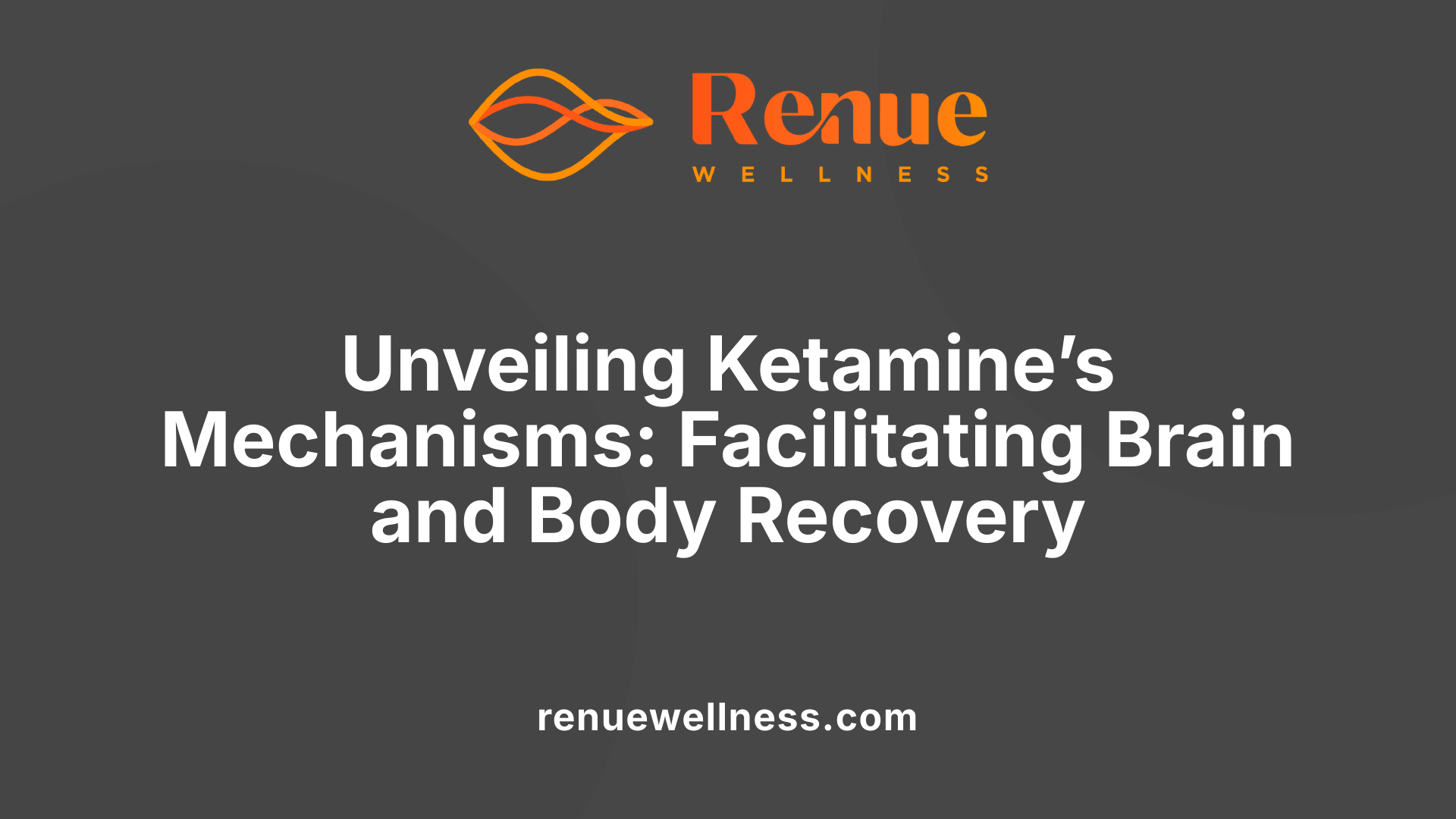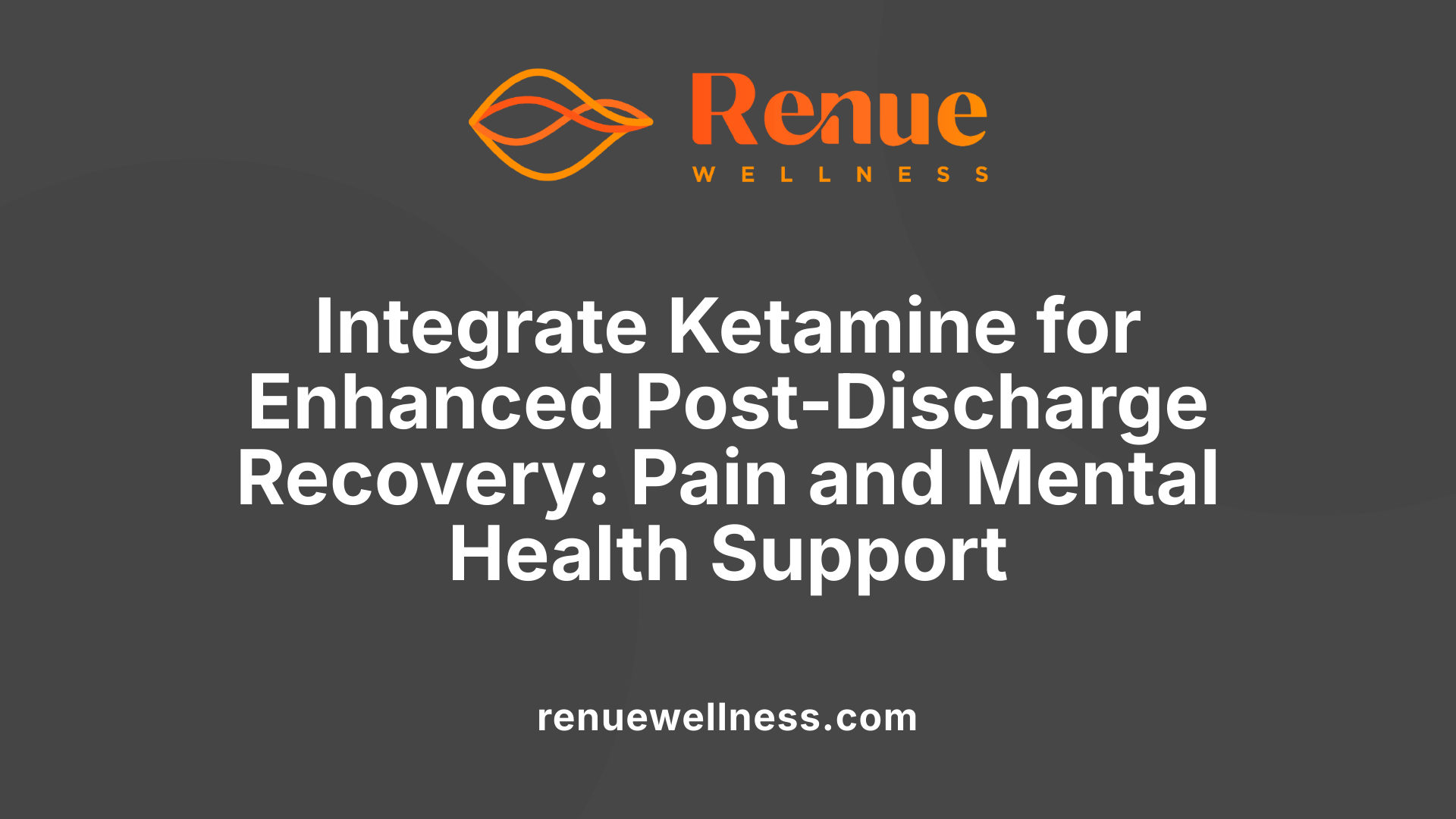Post-Hospital Discharge: How Ketamine Can Support Recovery


July 17, 2025
Unlocking the Potential of Ketamine in Recovery
Post-hospital recovery is a pivotal phase in patient care, where managing pain, mental health, and inflammation can determine long-term outcomes. Recent scientific advances highlight ketamine's multifaceted role in enhancing recovery processes. This article explores how ketamine supports optimal healing beyond the hospital setting, emphasizing evidence-based benefits, mechanisms of action, and safety protocols.
Ketamine as an Integral Component of Postoperative and Post-Discharge Recovery Strategies
How is ketamine integrated into overall post-hospital recovery strategies?
Ketamine plays a significant role in modern post-hospital recovery plans, especially in managing pain and improving long-term outcomes after surgery. Its primary use involves perioperative analgesia, where it is administered either as an initial bolus or as a continuous infusion lasting up to 48 hours. This approach is particularly effective because it targets NMDA receptors, helping to prevent central sensitization, which is often responsible for heightened pain responses and chronic pain development.
Multiple studies have demonstrated that perioperative ketamine reduces overall opioid consumption, pain scores, and incidence of persistent postoperative pain at long-term follow-up. This is especially beneficial in surgeries like knee replacement, lumbar spinal procedures, abdominal operations, and cesarean sections, where pain can be severe and recovery prolonged. By lowering opioid requirements, ketamine also decreases side effects such as nausea and vomiting, making recovery more comfortable.
Beyond its analgesic properties, ketamine supports the overall recovery process by stabilizing physiological responses during surgery and helping to reduce inflammation. For example, in breast cancer surgeries, high-dose s-ketamine infusion not only improved pain control but also lowered inflammatory markers like neutrophil counts and CRP levels, contributing to a smoother postoperative course.
Furthermore, the incorporation of ketamine extends into mental health aspects of recovery. Its rapid antidepressant effects can support patients suffering from depression or anxiety following surgery or chronic illness, thereby improving their emotional resilience and readiness to participate in rehabilitation activities.
Post-discharge, patients are encouraged to follow comprehensive recovery strategies that include engaging in physical therapy, mental wellness activities, and lifestyle modifications. These steps capitalize on the neuroplasticity promoted by ketamine, helping patients recover more completely and possibly preventing the transition to chronic pain or mood disorders.
In summary, ketamine’s integration into recovery strategies involves both immediate pain management and broader support of mental and physical health. Its ability to reduce opioid reliance, lower inflammation, and support neuroplasticity makes it a valuable tool in comprehensive postoperative care programs.
Use of ketamine for pain management after surgery
In clinical settings, ketamine’s use for postoperative pain management has garnered strong evidence. Administered before or during surgery and continued via infusion into the postoperative period, it has consistently shown benefits such as reduced pain scores and decreased need for opioids. These effects support faster mobilization, shorter hospital stays, and improved comfort.
The optimal dosing protocols often involve overdosing-dependent titrations, ensuring adequate plasma levels to prevent central hyperalgesia and tolerance. For example, a high-dose infusion of 0.2 mg/kg IV after induction, followed by a continuous infusion at the same rate, has been associated with better pain control and patient-reported recovery quality.
Beyond pain relief, ketamine’s anti-inflammatory effects—evident by lower neutrophil and CRP levels—further facilitate recovery and reduce complications such as shivering and nausea. Importantly, adverse effects like dizziness or hallucinations are generally comparable with placebo when administered under proper protocols, emphasizing its safety profile.
Integration of ketamine in comprehensive recovery plans
Integrating ketamine into recovery protocols involves multidisciplinary planning. Anesthesiologists and pain specialists typically oversee its usage, tailoring doses to individual patient needs. Preoperative assessment includes evaluating medical history, including cardiac and mental health status, to mitigate risks.
In outpatient and inpatient settings, protocols encompass baseline vital signs, informed consent, and continuous monitoring during administration. Post-treatment, patients are usually evaluated for both pain and mood improvement and are provided education on activities that promote neuroplasticity, such as mindfulness practices and gentle exercise.
Clinics specializing in outpatient ketamine therapy emphasize safety, with features like sterile infusion setups and emergency response equipment. Patients are monitored closely during and after treatment to detect any adverse events early. Follow-ups are essential to assess sustained benefits, adjust doses, or determine the need for retreatments.
Future perspectives and ongoing research
As research progresses, the role of ketamine in recovery strategies continues to expand. With evidence supporting its anti-inflammatory and neuroplasticity-enhancing effects, future protocols may further integrate ketamine into multimodal pain and mental health regimens. This convergence aims to improve patient outcomes, reduce reliance on opioids, and bolster resilience against long-term sequelae of surgery.
In conclusion, the use of ketamine within post-hospital recovery plans is multifaceted—covering pain management, inflammation control, emotional stabilization, and enhancing overall readiness for discharge and rehabilitation. Its versatility and effectiveness make it an indispensable component of modern perioperative care, promising better recovery experiences for patients.
Supporting Neuroplasticity and Mental Health During Recovery

Can ketamine support neuroplasticity and mental health during recovery?
Yes, ketamine plays a significant role in supporting neuroplasticity, which is vital for effective mental health recovery. Neuroplasticity refers to the brain's ability to reorganize itself by forming new neural connections, especially after injury, stress, or in mental health conditions like depression.
Research shows that ketamine rapidly enhances neuroplasticity by increasing dendritic spine density and promoting synaptic formation in crucial brain regions such as the medial frontal cortex. This process involves multiple molecular pathways, including dopaminergic signaling through Drd1 receptors and growth factor pathways like BDNF-TrkB. These pathways facilitate the strengthening and creation of new neural circuits, helping the brain adapt and recover.
The window during which ketamine induces these neuroplastic changes is relatively short, typically within 2 to 48 hours after administration. This period offers an optimal timeframe for combining pharmacological treatment with psychotherapy, behavioral adjustments, or cognitive rehabilitation for improved outcomes.
Neuroimaging studies further support ketamine's role in fostering brain rewiring. For example, decreases in Diffusion Tensor Imaging (DTI) mean diffusivity measurements are associated with enhanced neural connectivity and correlate with reductions in depression severity. These findings highlight how ketamine-induced neuroplasticity translates into tangible clinical improvements.
How does ketamine enhance cognitive and emotional recovery?
By promoting synaptic growth and strengthening neural circuits, ketamine helps restore normal brain function affected by persistent depression or trauma. This neuroplastic boost not only alleviates depressive symptoms but also improves cognitive functions such as concentration, memory, and decision-making.
Emotional regulation benefits from the metabolic and structural brain changes. Patients often report better mood stability, increased resilience, and improved emotional responses after ketamine treatment. These benefits are linked to the enhanced connectivity between prefrontal regions and limbic areas responsible for mood regulation.
What activities can boost neural rewiring after ketamine treatment?
Post-treatment activities play a pivotal role in consolidating the neuroplastic changes initiated by ketamine. Engaging in specific behaviors and therapies can maximize the brain's rewiring potential:
- Psychotherapy: Techniques such as cognitive-behavioral therapy (CBT) or mindfulness-based cognitive therapy can capitalize on increased neuroplasticity to reshape maladaptive thought patterns.
- Physical exercise: Aerobic activities like running, cycling, or swimming increase neurotrophic factors like BDNF, fostering further synaptic growth and resilience.
- Mindfulness and meditation: These practices boost neuroplasticity by reducing stress and enhancing neural connectivity, particularly in prefrontal and hippocampal regions.
- Cognitive stimulation: Puzzles, learning new skills, or engaging in stimulating social interactions encourage neural rewiring and support sustained mental health improvements.
- Healthy lifestyle choices: Adequate sleep, balanced diet rich in omega-3 fatty acids, and stress management techniques support ongoing brain repair mechanisms.
Implementing these strategies during the critical window of neuroplasticity can optimize recovery, helping patients build a resilient neural architecture to maintain mental health gains.
| Aspect | Explanation | Supporting Evidence |
|---|---|---|
| Neuroplastic Effects of Ketamine | Increases dendritic spine density and synapse formation in key brain regions | Imaging studies show correlates like decreased DTI mean diffusivity; molecular pathways involved include BDNF-TrkB (activation of growth factors) and dopaminergic signaling |
| Enhancement of Cognitive and Emotional Recovery | Restores neural circuit functionality, improves mood stability | Patients report mood improvements; enhanced connectivity between mood regulation regions |
| Activities to Boost Neural Rewiring | Psychotherapy, physical exercise, mindfulness, cognitive activities | These activities leverage the window of enhanced plasticity to reinforce healthy neural pathways |
This integrated approach — combining pharmacological support with targeted post-treatment activities — significantly enhances the potential for sustainable mental health recovery.
Mechanisms of Action: How Ketamine Facilitates Recovery

What are the mechanisms by which ketamine aids recovery?
Ketamine's ability to support recovery after surgery and in mental health conditions stems from its complex interactions within the brain. Central to its therapeutic effects is its role as an NMDA receptor antagonist. By blocking these receptors, ketamine increases the release of glutamate, the brain's primary excitatory neurotransmitter.
This surge in glutamate activates a series of pathways that promote neural plasticity. Specifically, it stimulates the production of brain-derived neurotrophic factor (BDNF), a crucial protein that supports the growth and survival of new neurons and synapses. Alongside BDNF, ketamine activates signaling cascades involving the mammalian target of rapamycin (mTOR) pathway and AMPA receptors, which further enhance synaptic strength and promote neural rewiring.
The promotion of synaptogenesis and neural rewiring helps in disrupting maladaptive neural networks, which is particularly beneficial in addiction recovery, reducing cravings, and improving emotional regulation. These neuroplastic changes lay the foundation for enduring behavioral change.
In addition to structural neural benefits, ketamine impacts neuroinflammation and pain pathways. Its anti-inflammatory effects can reduce cytokine activity and neuroinflammation, which are often elevated in chronic pain states and depression. This reduction contributes to lower pain perception and improved mood.
Furthermore, ketamine's rapid antidepressant effects help alleviate co-occurring mental health issues such as depression and anxiety that often impede recovery. Its ability to block reconsolidation of drug-related memories and to induce mystical or insightful experiences can also facilitate psychological processing and behavioral change.
When used in conjunction with psychotherapy, these combined neural and experiential effects foster resilience, support mental health stabilization, and promote sustained recovery. Overall, ketamine's multifaceted mechanisms make it a potent agent for enhancing neurobiological recovery processes and supporting lasting behavioral change.
Evidence-Based Benefits and Efficacy of Ketamine in Post-Hospital Recovery

What are the evidence-based benefits of ketamine in post-hospital recovery?
Scientific research provides compelling support for the use of ketamine in enhancing recovery after surgery and hospitalization. One of the most well-documented benefits is its ability to reduce opioid consumption. Studies in intensive care units (ICUs) have shown that administering ketamine as part of pain management protocols led to a significant decrease in the need for opioids like fentanyl. This opioid-sparing effect is particularly valuable in minimizing the risks associated with high-dose opioid use, such as dependency and adverse side effects.
Beyond pain control, ketamine has demonstrated promising mental health benefits. It has been notably effective in reducing symptoms of post-traumatic stress disorder (PTSD), especially in military veterans and trauma patients. Some research indicates that patients treated with ketamine experience sustained symptom relief lasting several months, highlighting its potential as an effective mental health intervention.
Meta-analyses and systematic reviews consistently show that ketamine can decrease postoperative pain scores and delay the time until the first analgesic request. This means patients often experience longer-lasting pain relief, which contributes to comfort and mobility during recovery.
Furthermore, ketamine's anti-inflammatory effects play an essential role in the healing process. It reduces levels of inflammatory markers such as C-reactive protein (CRP), neutrophil count, and neutrophil-lymphocyte ratios (NLR). Lower inflammation correlates with less tissue damage and faster healing, especially in complex surgeries like breast cancer operations.
In terms of physical recovery, studies involving surgeries such as cleft palate repairs, adenotonsillectomies, lumbar spinal procedures, knee replacements, abdominal surgeries, and cesarean sections reveal consistent results. Patients receiving ketamine report lower pain scores, require fewer opioids, and experience fewer side effects like nausea and vomiting.
Another significant aspect is the improvement in overall recovery quality. For instance, high-dose intravenous S-ketamine has been associated with better quality of recovery scores at 24 hours post-surgery. These scores, measured by tools like QoR-40, reflect physical comfort, emotional well-being, and pain management—showing that ketamine can positively influence multiple dimensions of recovery.
When administered appropriately, ketamine is generally well tolerated, with adverse effects such as dizziness, drowsiness, and mild hallucinations being transient. Importantly, research shows no significant increase in serious side effects when used in controlled settings.
In summary, the evidence underscores ketamine's multifaceted role in postoperative recovery. It not only alleviates pain and reduces reliance on opioids but also diminishes inflammation, supports mental health, and enhances overall recovery experience. While promising, ongoing studies aim to optimize dosing strategies and long-term impact, ensuring safer and more effective integration into standard clinical practice.
Use of Ketamine for Post-Discharge Pain Management and Mental Health Support

How is ketamine used in post-discharge recovery, pain management, and mental health support?
Ketamine plays a significant role in enhancing post-discharge recovery by offering rapid relief from various pain conditions. It is commonly administered as an infusion, nasal spray, or oral formulation, providing flexibility to suit individual patient needs. In pain management, ketamine helps control both acute and chronic pain by blocking NMDA receptors, which reduces central sensitization and hyperalgesia. Its ability to decrease opioid consumption is particularly valuable in reducing reliance on opioids and minimizing side effects like nausea and respiratory depression.
In addition to pain relief, ketamine is an important option for supporting mental health. It is especially effective for treatment-resistant depression and suicidal ideation. The FDA-approved esketamine nasal spray is widely used in clinical settings for rapid antidepressant effects, often within hours of administration. These treatments help stabilize mood and reduce depressive symptoms, improving overall recovery.
Neuroplasticity enhancement is another benefit associated with ketamine use. By stimulating glutamate receptors, ketamine promotes synapse formation and emotional resilience, aiding recovery from mental health conditions. This is particularly useful in conjunction with psychotherapy and lifestyle adjustments, such as mindfulness and physical activity.
In emergency and surgical settings, ketamine’s anesthetic and bronchodilatory properties help stabilize patients after procedures. It ensures safe recovery by maintaining vital functions while minimizing discomfort or agitation.
Overall, ketamine's versatile application during and after hospitalization addresses vital recovery needs—relieving pain, supporting mental health, and ensuring safety—making it a comprehensive tool in modern post-discharge care.
Enhancing Recovery Outcomes Through Ketamine Infusions
How do ketamine infusions enhance recovery outcomes after hospitalization?
Ketamine infusions play a significant role in improving recovery experiences following surgery. Their primary mechanism involves NMDA receptor antagonism, which helps prevent central nervous system sensitization—an underlying factor in persistent pain and hyperalgesia. By counteracting these processes, ketamine effectively reduces postoperative pain and the need for opioids, leading to fewer opioid-related side effects such as nausea and vomiting.
Research shows that when administered as a preoperative bolus coupled with continuous postoperative infusion for up to 48 hours, ketamine produces notable benefits. These include higher recovery quality scores, such as the QoR-40 and QoR-15, which assess physical comfort, emotional well-being, and independence. One high-dose s-ketamine regimen (0.2 mg/kg IV after induction plus 0.2 mg/kg/h infusion) has even demonstrated improved overall recovery quality at 24 hours.
Moreover, ketamine's anti-inflammatory effects contribute to faster recovery. Studies report significantly lower levels of inflammatory markers like C-reactive protein (CRP), neutrophil counts, and neutrophil-lymphocyte ratios after high-dose infusions. This reduction in inflammation helps slow the body's stress response, minimize pain, and facilitate healing.
Patients undergoing diverse surgeries—including breast surgeries, spine operations, knee replacements, and abdominal procedures—have benefited from ketamine’s analgesic properties. This support often results in shorter hospital stays, earlier discharge, and less reliance on opioids during recovery.
In summary, ketamine infusions aid recovery by providing potent pain relief, decreasing inflammatory responses, and promoting physical and emotional well-being, all with minimal adverse effects. Nonetheless, ongoing research continues to refine protocols and confirm widespread benefits across various surgical contexts.
What protocols involving bolus and infusion are most effective?
Effective ketamine protocols often involve a combination of a preoperative bolus dose and continuous postoperative infusion. The bolus dose is typically administered just before or during surgery to establish early pain control. Following this, a continuous infusion—lasting up to 48 hours—maintains analgesic effects and prevents central sensitization.
Studies suggest that overdose-dependent dosing protocols yield better outcomes. For example, higher doses like 0.2 mg/kg IV after induction, combined with an infusion of 0.2 mg/kg/h, have improved postoperative recovery scores and reduced inflammatory markers.
The timing and dose are critical factors. Administering the infusion shortly after surgery ensures sustained analgesia without increasing adverse effects. Monitoring for side effects is crucial, but with proper oversight, high-dose regimens are well tolerated.
In certain cases, oral ketamine at low doses (e.g., 30 mg) has been safely used post-spinal surgery to support recovery, reducing opioid needs without compromising safety.
Overall, structured protocols incorporating both bolus and infusion, tailored to surgical type and patient needs, appear most effective in maximizing pain relief and supporting recovery.
What are the effects on pain, opioid consumption, and inflammatory markers?
Ketamine significantly impacts postoperative pain management by decreasing pain intensity and delaying the need for additional analgesics. Meta-analyses and systematic reviews confirm that ketamine reduces opioid consumption and prolongs the time until the first analgesic request.
Patients receiving ketamine infusions often report lower pain scores at multiple time points post-surgery. This reduction is particularly beneficial in surgeries prone to severe postoperative pain such as knee replacements, thoracic, and abdominal surgeries.
Reducing opioid use is crucial due to associated side effects like nausea, vomiting, respiratory depression, and potential dependency. Ketamine’s opioid-sparing effect helps mitigate these risks, enabling smoother recovery.
Inflammatory markers, such as CRP, neutrophil counts, and neutrophil-lymphocyte ratios, are also lowered in patients treated with high-dose ketamine infusions. This anti-inflammatory action helps reduce tissue stress, decreases pain, and enhances healing.
By attenuating neuroinflammation and central sensitization, ketamine supports a less painful, more manageable postoperative course.
How do these protocols influence patient outcomes and hospital stay duration?
Patients treated with ketamine infusion protocols tend to experience shorter hospital stays and earlier discharge. This is largely due to effective pain control, reduced opioid-related complications, and faster mobilization.
Higher quality recovery scores, such as QoR-40, reflect overall better patient experiences, including improved physical comfort, emotional stability, and physical independence.
Despite these positive outcomes, some studies show no significant difference in scores like QoR-15 at certain time points, indicating that effects can vary depending on the surgical procedure and individual patient factors.
Nevertheless, the overall trend favors postoperative ketamine use as an adjunct to standard pain management, promoting a quicker, more comfortable recovery process.
A summary table of effects, protocols, and outcomes:
| Aspect | Description | Additional Details |
|---|---|---|
| Analgesic effect | Significant pain reduction | Especially with perioperative bolus & infusion |
| Opioid sparing | Reduced opioid consumption | Notably on days 3 and 7 post-surgery |
| Inflammatory response | Lower levels of CRP & neutrophil count | Supports faster healing and less pain |
| Recovery scores | Improved QoR-40 & QoR-15 | Higher scores indicate better recovery quality |
| Protocols | Bolus + infusion, typically up to 48h | Dose: 0.2 mg/kg IV + 0.2 mg/kg/h infusion |
| Safety profile | Minimal adverse effects | Dizziness, nausea, and hallucinations are comparable to controls |
| Hospital stay | Shorter length | Earlier discharge and reduced days on oral opioids |
By integrating these elements into clinical practice, healthcare providers can enhance postoperative recovery, ensuring patients experience less pain and a smoother path to healing.
Clinical Applications and Protocols for Ketamine Therapy Post-Hospitalization
What are the safety considerations and treatment protocols for ketamine therapy after hospitalization?
Following hospital discharge, ketamine therapy must proceed under strict safety and clinical guidelines to ensure patient well-being. This protocols are designed to minimize risks and optimize therapeutic outcomes.
Before starting treatment, a comprehensive medical evaluation is essential. This includes reviewing the patient’s medical history, conducting a physical exam, and screening for contraindications such as psychosis, substance abuse, or unstable cardiovascular conditions. Patients should be fully informed about potential adverse effects, including dissociation, increased blood pressure, or cognitive changes.
During the infusion sessions, vital signs are closely monitored. Medical professionals observe for signs of hypertension, dysphoria, hallucinations, or other adverse reactions. Emergency equipment such as resuscitation tools and medications are kept on hand to promptly address any complications.
Ketamine dosing protocols are tailored to individual needs, often involving initial low doses with gradual titration. The duration, frequency, and total number of infusions are carefully planned based on response and safety considerations. For example, infusion sessions typically last 45-60 minutes, with monitoring before, during, and after.
Post-treatment assessments are vital for ongoing safety. Patients undergo psychiatric evaluations to monitor for mood improvement, signs of misuse, or emergence of side effects. Regular check-ins help adjust doses and determine the necessity for continued therapy.
Proper drug handling procedures, including secure storage and disposal, prevent diversion or misuse. Documentation of each session, patient responses, and adverse events should be meticulously maintained.
Ethical considerations include informed consent, respecting patient autonomy, and ensuring confidentiality. Healthcare providers must be qualified in managing psychiatric and cardiovascular risks, with certifications such as ACLS or similar.
In sum, ketamine therapy after hospitalization requires a multidisciplinary approach, combining medical expertise, patient education, vigilant monitoring, and adherence to established safety protocols. This comprehensive approach promotes effective and safe treatment outcomes while minimizing potential risks.
Monitoring during administration
During each infusion, continuous assessment of vital signs and mental status is critical. ECG monitoring may be employed for patients with cardiovascular risks. Patients are observed for dissociative symptoms, hypertension, or nausea. If adverse effects occur, protocols for intervention are enacted immediately.
After the infusion, patients are monitored until their vital signs return to baseline or are stable within safe parameters. They should remain under observation until any sedation or side effects resolve.
Follow-up and ongoing assessment
Post-treatment plans include regular psychiatric evaluations to gauge mood improvements and detect any early signs of adverse reactions. Follow-up appointments assess cognitive function, psychological state, and the need for dose adjustments.
Long-term safety monitoring is essential, especially for repeated infusions. Patients may be evaluated for signs of dependence, cognitive changes, or emerging psychiatric symptoms.
Educational support and counseling may be provided to optimize treatment adherence and address any psychosocial issues. Ethical healthcare practices emphasize patient autonomy and informed decision-making throughout the treatment process.
In summary, strict safety measures, vigilant monitoring, and comprehensive post-treatment follow-up are crucial for the effective and safe use of ketamine therapy after hospitalization. These protocols help maximize benefits while safeguarding against potential risks.
Research and Future Directions in Ketamine Post-Discharge Recovery

What scientific evidence supports the use of ketamine in post-hospital recovery?
Recent studies have demonstrated that ketamine can play a significant role in enhancing recovery after hospital procedures, especially in managing pain and mental health conditions.
One of the primary ways ketamine supports recovery is through its opioid-sparing effects. In intensive care units (ICUs), research has shown that ketamine infusion significantly reduces the amount of fentanyl required for pain control without increasing adverse effects. This helps minimize opioid-related side effects and risks, such as dependency.
In addition to pain management, ketamine has shown promise in treating trauma-related conditions like post-traumatic stress disorder (PTSD). Several studies report that a single or repeated ketamine infusions can lead to substantial and sustained symptom relief, sometimes lasting several months. This has been particularly valuable for patients with treatment-resistant PTSD, where traditional therapies often fall short.
Systematic reviews and meta-analyses further support ketamine's potential by indicating a modest but statistically significant reduction in PTSD symptoms. These findings suggest that ketamine could form part of an integrated approach to post-hospital recovery, targeting both pain and psychological trauma.
Moreover, evidence from postoperative studies shows that ketamine facilitates pain relief, reduces opioid consumption, and contributes to overall patient comfort. When administered correctly, ketamine's side effects—such as dizziness, nausea, or hallucinations—are typically transient and manageable.
While existing research highlights promising outcomes, it also underscores the need for more extensive studies. Researchers are exploring optimal dosing protocols, long-term safety, and the potential combination of ketamine with other therapies. The goal is to establish standardized treatment guidelines that maximize benefits and minimize risks.
In summary, current scientific data support ketamine's role in improving post-hospital recovery through pain reduction and mental health support. Nevertheless, ongoing research is crucial to confirm these benefits, determine long-term safety, and develop comprehensive treatment strategies.
Optimizing Recovery with Innovative Therapies
The landscape of post-hospital recovery is evolving with the integration of ketamine therapy, recognized for its efficacy in alleviating pain, fostering neuroplasticity, and improving mental health. Its multifaceted mechanisms—ranging from NMDA receptor antagonism to inflammation reduction—make it a valuable tool in comprehensive recovery programs. As ongoing research clarifies optimal protocols and safety measures, healthcare providers are better equipped to utilize ketamine to support faster, more resilient recovery. Combining clinical expertise with emerging scientific insights promises to enhance patient outcomes, reduce reliance on opioids, and empower patients to reclaim their health post-discharge. Embracing these advances can pave the way for more personalized, effective post-hospital care strategies, ultimately transforming recovery trajectories.
References
- Role of Ketamine in Acute Postoperative Pain Management
- Effects of S-ketamine on Postoperative Recovery Quality and ...
- Oral ketamine for acute postoperative analgesia (OKAPA) trial
- Ketamine Clinic | Psychiatry - Michigan Medicine
- A RECOVERY STORY: After Every Available Option Was Exhausted ...
- Helpful Tips for Maintaining the Safety of Ketamine Infusion Therapy
- What to Do After Ketamine Treatment: Proven Steps to Boost ...
Recent Posts
Conditions Treated
AnxietyDepressionOCDPTSDPostpartum DepressionPain ManagementSubstance AbuseSuicidal IdeationOur Location


